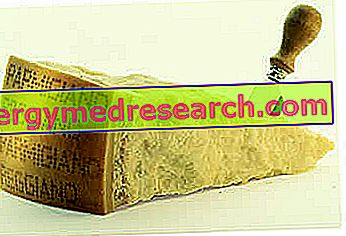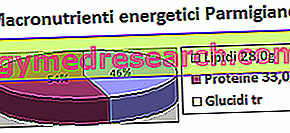Generality
Parmesan cheese is a seasoned cheese typical of northern Italy, more precisely in the Po valley (an area between central-western Emilia and Mantua).

Being a PDO (Protected Designation of Origin) product, Parmesan cheese is strictly regulated by the specific production disciplinary and this guarantees (or standardizes) the general quality level.
Background
It seems that the Parmigiano Reggiano was born about 900-1000 years ago (XI-XII century AD), in the same areas where it is still produced (Parma, Reggio Emilia, Modena, Bologna to the left of the Reno river and Mantua south of the Po river ). Its discovery, like that of the Grana Padano, is attributed to the Benedictine and Cistercian monks of Parma and Reggio Emilia. Catholics could also be attributed to the reclamation of the surrounding territories (previously occupied by the woods), which then became the site of harvests and pastures for the Red Reggiana cow (a breed of animal belonging to the Bovidae family, Genus Bos, Species taurus ).
Thanks to the luxuriance of the meadows, the productivity of the livestock and the richness of the waterways, the abundance of milk led the monks to devise a system of conservation of this food: cheese making. Initially, parmigiano reggiano (as well as grana padano) was generically called caseus vetus (to indicate its maturing), while outside the production areas it could be known with the caseus case parmensis (to indicate the place of origin).
Only in 1928 AD, in Reggio Emilia, the voluntary consortium of Grana Reggiano was born; in parallel, in Parma the independent marking began (with the ducal crown as a symbol). The producers of all the typical areas (with the exception of the Bolognese) only joined in '34, forming the much larger Voluntary Interprovincial Consortium of Typical Grain. In 1937 the current boundaries of the deputy area were defined completely, which also included the area of Bologna. Finally, in 1938 the name Parmigiano Reggiano was used for the first time.
The DOP title was approved by the European regulation of the EEC Reg. 2081/92 and the recognition of the Reg. (CE) N. 1107/96. The relative marks of origin are: the signs of the fascera on the barefoot of the form, which are shown as dots arranged in writing "Parmigiano reggiano", the number of the dairy matriculation date, the date "DOP" and that "Consorzio Tutela" ", the superficial casein plaque citing the year of production, the word" CFPR "and the alpha-numeric code of the form.
Production Regulations for Parmigiano Reggiano
According to the production disciplinary, Parmesan cheese is a hard cheese, cooked and slowly matured, produced with partially skimmed raw milk (for natural outcrop) and coming from food cows with fodder from the area of origin.
The milk used for Parmesan cheese CANNOT be subjected to heat treatments and the use of food additives is NOT allowed (the sodium glutamate present in the cheese is the fruit of the natural link between the glutamic acid of proteins and the sodium of chloride of sodium). To the milk of origin (which must comply with the production requirements) must be added the whey-grafting (natural culture of enzymes deriving from the spontaneous acidification of the residual serum of the previous day).
Later, calf rennet is added for protein coagulation; in this way we obtain a mass of curd for the production of two forms for each container (copper boiler). The curd of Parmesan cheese is therefore broken, cooked and left to decant. The cheese mass is then collected and placed in the molds.
After a few days the salting in brine of the forms takes place and the subsequent maturation continues for at least 12 months (counted by the forming).
The form of Parmesan cheese is externally cylindrical in shape, with 2 flat sides 35-45cm wide, about 20-26cm high, with a weight of at least 30kg and a straw yellow rind. The cheese paste is fragrant, delicate, tasty and NOT spicy, with a characteristic flavor and aroma; structurally, it appears minutely grainy and with flake fracture. The thickness of the rind is about 6mm and the fat on the DRY SUBSTANCE corresponds to a minimum of 32%.
The quality control takes place progressively by means of visual, olfactory, gustatory and auditory tests; special tools are also used such as the needle and the hammer.
For information regarding the marking it is recommended to consult the regulations of the specification.
Commodity classification of Parmigiano Reggiano
Parmesan cheese is not all the same. It is classified into 5 different types, respectively:
- Selected Parmigiano Reggiano Sperlato: shapes without defects
- Parmigiano Reggiano Zero and Uno: the first presents superficial cracks, erosions, rounded edges and corrections; the second can show slight anomalies such as: blisters, sponginess of the dough, eyes, puffs, sparse eyes and with a dull sound
- Parmigiano Reggiano Mezzano: shapes with larger bladders, sponginess, widespread holes, horizontal cracks, various corrections (always without olfactory alterations)
- Scrap cheese: shapes with bulges, sponginess and widespread holes, multiple cracks, splits, large central cavity, deep and extensive corrections, obvious olfactory defects
Scartone cheese: numerous and serious defects, superior to those just mentioned.Composition for: 100g of Parmesan - Reference values of the INRAN Food Composition Tables 
Nutritional values (per 100 g of edible portion)
Edible part 100% water 30.4g Protein 33.5g Prevailing amino acids B.C. Glutamic, Proline, Leucine Limiting amino acid Tript Lipids TOT 28.1g Saturated fatty acids 18.54mg Monounsaturated fatty acids 8.81mg Polyunsaturated fatty acids 0.79mg Cholesterol 91.0mg TOT Carbohydrates tr Starch 0.0g Soluble sugars tr Dietary fiber 0.0g Soluble fiber 0.0g Insoluble fiber 0.0g Power 387.0kcal Sodium 600.0mg Potassium 102.0mg Iron 0.7mg Football 1159.0mg Phosphorus 678.0mg Thiamine 0.03mg Riboflavin 0.37mg Niacin 0.05mg Vitamin A 373μg C vitamin 0.0mg Vitamin E 0.68mg
Nutritional Features
Parmesan cheese, like grana padano, is considered one of the most digestible cheeses, thanks to the not excessive presence of fats (for skimming the milk from the start) and to the greater hydrolysis by the lactic bacteria (operated on lactose and, to a lesser extent, on proteins); on the other hand, it is not in any case classifiable as objectively "light" because, being seasoned, it has a low level of hydration and a high energy-nutritional concentration.
The nutritional characteristics of Parmesan cheese are different; first of all, it contains little lactose and this makes it suitable (almost always) also in the diet of the intolerant to this sugar. It also provides a significant concentration of high biological value proteins, which is very interesting for sportsmen, for growing subjects, for vegetarians and for those suffering from intestinal malabsorption.
The breakdown of fatty acids is not the best, as most of them are saturated; fortunately, being derived from partially skimmed milk, the absolute quantity is still acceptable. The cholesterol is high and this makes it a food to be consumed in moderation in case of hypercholesterolemia.
As far as vitamins are concerned, Parmesan cheese is rich in riboflavin (vit. B2) and retinol (vit. A); on the contrary, from the saline point of view, especially minerals essential for the growth / maintenance of bones, such as calcium (100 grams of Parmesan cheese abundantly cover the needs of an adult) and phosphorus abound. Also among the minerals, sodium also abounds, which on the contrary represents a major limitation to clinical nutrition, since it excludes - or strongly limits - cheese from the diet against arterial hypertension (such as cholesterol for hypercholesterolemia).
We reiterate that the high concentration of sodium glutamate is the fruit of the natural union between free amino acids and added salt sodium; its presence does not therefore indicate the use of flavor enhancers. However, consideration should be given to individual hypersensitivity to sodium glutamate.
The consumption of Parmesan cheese is suitable both in association with first courses (grated, in portions of 5-10g), and as a dish in its own right (in portions of about 70-80g, depending on the case).




